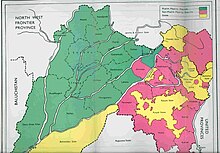Balloki Headworks

Head Balloki or Balloki Headworks is a barrage on the Ravi River in the Punjab province of Pakistan. It is 70 KM distant from Lahore. It was built around in 1915 under the British India as part of the 'Triple Canals Project' to feed the Lower Bari Doab Canal. The canal turned in a profit of 24% within ten years (in 1928–29).[1] The original weir has now been rebuilt as a full barrage.
History[edit]

The Triple Canals project in Punjab began in 1905, soon after the completion of the Upper Bari Doab Canal (UBDC).[citation needed] Thus, it was the second irrigation project to be implemented in Punjab. It constructed three canals:
- the Upper Jhelum Canal (UJC) from Mangla
- the Upper Chenab Canal (UCC) from Marala
- the Lower Bari Doab Canal (LBDC) from Balloki.
The Upper Chenab and Lower Bari were linked at Balloki. The former brought water from the Chenab River to the Ravi River, and recharged it after depletion into the Upper Bari Canal. The Lower Bari Doab Canal then took the combined waters from the Ravi River and UCC down the Bari doab for irrigating lands.[2]
This marked the inception of the "link canal" concept, a notion aimed at transferring water from the western rivers to the eastern rivers of Punjab. It was this concept that eventually laid the groundwork for the Indus Waters Treaty between contemporary India and Pakistan.[citation needed]
A short distance to the west of Balloki village, where the Upper Chenab river met the Ravi river, the Balloki Barrage was constructed. It was the largest barrage of its kind in India at that era. It had a 1,647-foot-long weir with thirty-five 12-metre-wide steel gates for regulating the water of Ravi. The Lower Bari Doab Canal branched off on the left of the barrage.[2] This canal commenced water supply operations in 1912 and achieved full completion in 1917. It irrigated 877,000 acres of land in the Montgomery and Multan districts.[1] The total cost of the LBDC project was Rs. 22 million. It became profitable within 10 years.[1]
See also[edit]
References[edit]
- ^ a b c Naqvi, Indus Waters and Social Change (2012), pp. 24–25.
- ^ a b Headrick, The Tentacles of Progress (1988), p. 192.
Bibliography[edit]
- Chaturvedi, Mahesh Chandra (2011), India's Waters: Environment, Economy, and Development, CRC Press, ISBN 978-1-4398-7283-3
- Headrick, Daniel R. (1988), The Tentacles of Progress: Technology Transfer in the Age of Imperialism, 1850-1940, Oxford University Press, ISBN 978-0-19-802178-0
- Naqvi, Saiyid Ali (2012), Indus Waters and Social Change: The Evolution and Transition of Agrarian Society in Pakistan, Oxford University Press Pakistan, ISBN 978-0-19-906396-3
